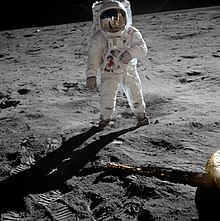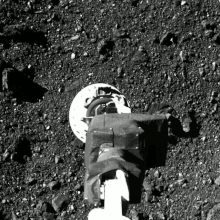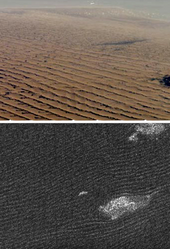
An asteroid is a minor planet—an object that is neither a true planet nor a comet—that orbits within the inner Solar System. They are rocky, metallic, or icy bodies with no atmosphere. The size and shape of asteroids vary significantly, ranging from small rubble piles under a kilometer across to Ceres, a dwarf planet almost 1000 km in diameter.

A planet is a large, rounded astronomical body that is neither a star nor its remnant. The best available theory of planet formation is the nebular hypothesis, which posits that an interstellar cloud collapses out of a nebula to create a young protostar orbited by a protoplanetary disk. Planets grow in this disk by the gradual accumulation of material driven by gravity, a process called accretion. The Solar System has at least eight planets: the terrestrial planets Mercury, Venus, Earth, and Mars, and the giant planets Jupiter, Saturn, Uranus, and Neptune.

The Solar System is the gravitationally bound system of the Sun and the objects that orbit it. It was formed 4.6 billion years ago when a dense region of a molecular cloud collapsed, forming the Sun and a protoplanetary disc. The Sun is an ordinary main sequence star that maintains a balanced equilibrium by the fusion of hydrogen into helium at its core, releasing this energy from its outer photosphere.

Triton is the largest natural satellite of the planet Neptune. It is the only moon of Neptune massive enough to be rounded under its own gravity and hosts a thin but well-structured atmosphere. Triton orbits Neptune in a retrograde orbit—an orbit in the direction opposite to its planet's rotation—the only large moon in the Solar System to do so. Triton is thought to have once been a dwarf planet, captured from the Kuiper belt into Neptune orbit.

Pallas is the third-largest asteroid in the Solar System by volume and mass. It is the second asteroid to have been discovered, after Ceres, and is a likely remnant protoplanet. Like Ceres, it is believed to have a mineral composition similar to carbonaceous chondrite meteorites, though significantly less hydrated than Ceres. It is 79% the mass of Vesta and 22% the mass of Ceres, constituting an estimated 7% of the mass of the asteroid belt. Its estimated volume is equivalent to a sphere 507 to 515 kilometers in diameter, 90–95% the volume of Vesta.

A terrestrial planet, telluric planet, or rocky planet, is a planet that is composed primarily of silicate, rocks or metals. Within the Solar System, the terrestrial planets accepted by the IAU are the inner planets closest to the Sun: Mercury, Venus, Earth and Mars. Among astronomers who use the geophysical definition of a planet, two or three planetary-mass satellites – Earth's Moon, Io, and sometimes Europa – may also be considered terrestrial planets. The large rocky asteroids Pallas and Vesta are sometimes included as well, albeit rarely. The terms "terrestrial planet" and "telluric planet" are derived from Latin words for Earth, as these planets are, in terms of structure, Earth-like. Terrestrial planets are generally studied by geologists, astronomers, and geophysicists.

Tholins are a wide variety of organic compounds formed by solar ultraviolet or cosmic ray irradiation of simple carbon-containing compounds such as carbon dioxide, methane or ethane, often in combination with nitrogen or water. Tholins are disordered polymer-like materials made of repeating chains of linked subunits and complex combinations of functional groups, typically nitriles and hydrocarbons, and their degraded forms such as amines and phenyls. Tholins do not form naturally on modern-day Earth, but they are found in great abundance on the surfaces of icy bodies in the outer Solar System, and as reddish aerosols in the atmospheres of outer Solar System planets and moons.

A cryovolcano is a type of volcano that erupts gases and volatile material such as liquid water, ammonia, and hydrocarbons. The erupted material is collectively referred to as cryolava; it originates from a reservoir of subsurface cryomagma. Cryovolcanic eruptions can take many forms, such as fissure and curtain eruptions, effusive cryolava flows, and large-scale resurfacing, and can vary greatly in output volumes. Immediately after an eruption, cryolava quickly freezes, constructing geological features and altering the surface.

Ceres is a dwarf planet in the middle main asteroid belt between the orbits of Mars and Jupiter. It was the first known asteroid, discovered on 1 January 1801 by Giuseppe Piazzi at Palermo Astronomical Observatory in Sicily, and announced as a new planet. Ceres was later classified as an asteroid and then a dwarf planet, the only one inside Neptune's orbit.

There is evidence that the formation of the Solar System began about 4.6 billion years ago with the gravitational collapse of a small part of a giant molecular cloud. Most of the collapsing mass collected in the center, forming the Sun, while the rest flattened into a protoplanetary disk out of which the planets, moons, asteroids, and other small Solar System bodies formed.

A dwarf planet is a small planetary-mass object that is in direct orbit around the Sun, massive enough to be gravitationally rounded, but insufficient to achieve orbital dominance like the eight classical planets of the Solar System. The prototypical dwarf planet is Pluto, which for decades was regarded as a planet before the "dwarf" concept was adopted in 2006.
Extraterrestrial liquid water is water in its liquid state that naturally occurs outside Earth. It is a subject of wide interest because it is recognized as one of the key prerequisites for life as we know it and is thus surmised to be essential for extraterrestrial life.
The presence of water on the terrestrial planets of the Solar System varies with each planetary body, with the exact origins remaining unclear. Additionally, the terrestrial dwarf planet Ceres is known to have water ice on its surface.

According to the International Astronomical Union (IAU), a minor planet is an astronomical object in direct orbit around the Sun that is exclusively classified as neither a planet nor a comet. Before 2006, the IAU officially used the term minor planet, but that year's meeting reclassified minor planets and comets into dwarf planets and small Solar System bodies (SSSBs). In contrast to the eight official planets of the Solar System, all minor planets fail to clear their orbital neighborhood.
In astronomy, a phase curve describes the brightness of a reflecting body as a function of its phase angle. The brightness usually refers the object's absolute magnitude, which, in turn, is its apparent magnitude at a distance of one astronomical unit from the Earth and Sun.

The Late Heavy Bombardment (LHB), or lunar cataclysm, is a hypothesized astronomical event thought to have occurred approximately 4.1 to 3.8 billion years (Ga) ago, at a time corresponding to the Neohadean and Eoarchean eras on Earth. According to the hypothesis, during this interval, a disproportionately large number of asteroids and comets collided into the terrestrial planets and their natural satellites in the inner Solar System, including Mercury, Venus, Earth and Mars. These came from both post-accretion and planetary instability-driven populations of impactors. Although it gained widespread credance, definitive evidence remained elusive. However, recent re-appraisal of the cosmo-chemical constraints suggest there was no late spike in the bombardment rate.
Planetary oceanography, also called astro-oceanography or exo-oceanography, is the study of oceans on planets and moons other than Earth. Unlike other planetary sciences like astrobiology, astrochemistry, and planetary geology, it only began after the discovery of underground oceans in Saturn's moon Titan and Jupiter's moon Europa. This field remains speculative until further missions reach the oceans beneath the rock or ice layer of the moons. There are many theories about oceans or even ocean worlds of celestial bodies in the Solar System, from oceans made of diamond in Neptune to a gigantic ocean of liquid hydrogen that may exist underneath Jupiter's surface.
Comparative planetary science or comparative planetology is a branch of space science and planetary science in which different natural processes and systems are studied by their effects and phenomena on and between multiple bodies. The planetary processes in question include geology, hydrology, atmospheric physics, and interactions such as impact cratering, space weathering, and magnetospheric physics in the solar wind, and possibly biology, via astrobiology.






















